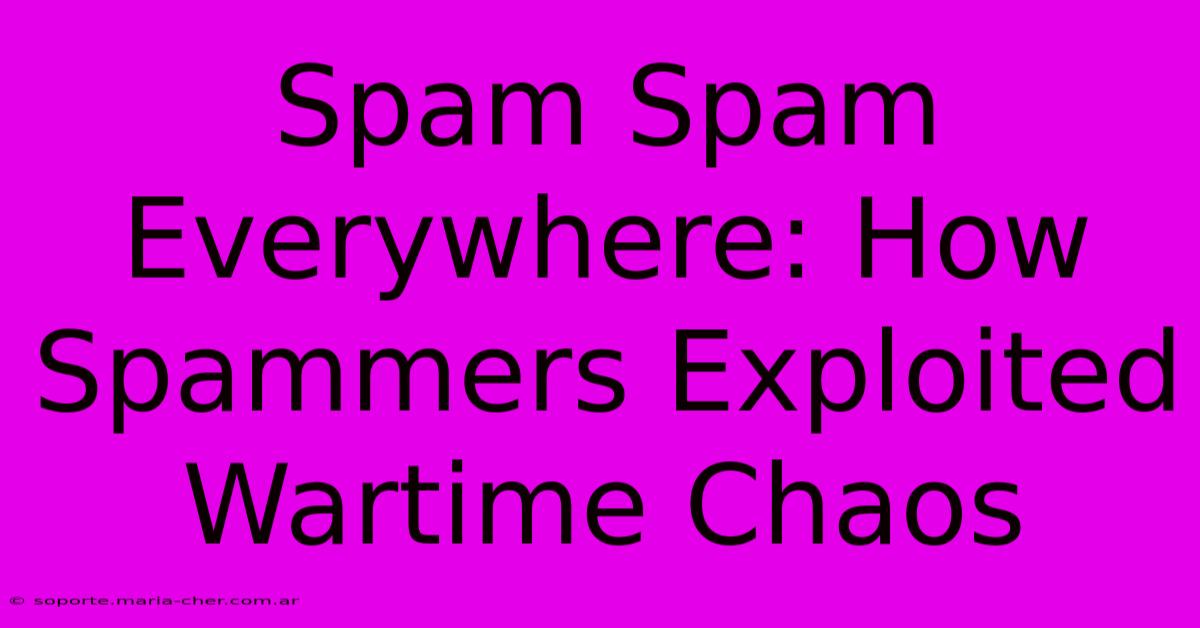Spam Spam Everywhere: How Spammers Exploited Wartime Chaos

Table of Contents
Spam Spam Everywhere: How Spammers Exploited Wartime Chaos
The world is currently facing unprecedented challenges due to the ongoing conflict in Ukraine. Amidst the humanitarian crisis and global uncertainty, a less visible but equally insidious threat has emerged: a surge in spam and phishing attacks. This isn't a new phenomenon – history shows us that wartime chaos consistently creates fertile ground for malicious actors to exploit vulnerabilities. This article delves into how spammers historically capitalized on periods of conflict, focusing on the parallels between past events and the current situation.
The Perfect Storm: War, Uncertainty, and Vulnerable Populations
War creates a perfect storm for spam proliferation. Several factors contribute to this:
-
Increased Anxiety and Fear: In times of conflict, people are more susceptible to emotional manipulation. Spammers prey on this by crafting messages designed to evoke fear, urgency, or a sense of false security. Phishing attempts often mimic official government communications or charitable organizations, leveraging the public's trust to gain access to personal information.
-
Disrupted Infrastructure: War often disrupts communication networks and essential services. This leaves individuals more reliant on digital communication, making them more vulnerable to online attacks. Spammers take advantage of these disruptions, exploiting gaps in security and exploiting the heightened dependence on online services.
-
Information Overload and Confusion: The sheer volume of information surrounding a conflict can be overwhelming. This makes it easier for malicious emails and messages to blend in, making it harder for individuals to distinguish legitimate information from deceptive content. This is amplified by the spread of misinformation and propaganda.
-
Increased Charitable Giving: Wars often lead to an increase in charitable giving. This creates a ripe opportunity for scammers to create fake charities, soliciting donations that never reach their intended recipients. These fraudulent schemes prey on people's goodwill and desire to help those affected by the conflict.
Historical Parallels: Lessons from the Past
Examining past conflicts reveals recurring patterns in how spammers exploit wartime conditions:
-
World War II: While the internet didn't exist, spam existed in other forms. Propaganda and misinformation were rampant, spread through leaflets, radio broadcasts, and other means. Similar tactics are used today, albeit through digital channels.
-
The Cold War: The Cold War saw an escalation in espionage and disinformation campaigns. The techniques used then – sowing distrust and creating confusion – are still relevant in modern cyber warfare.
-
The Gulf War and Beyond: The advent of the internet opened up new avenues for spammers. Following the Gulf War, we saw the early stages of online phishing and scams, exploiting public concern and the need for information.
These historical examples highlight the consistent adaptability of spammers. They leverage the unique vulnerabilities created by each conflict to maximize their impact.
Protecting Yourself in Times of Crisis
Staying vigilant and informed is crucial during periods of conflict:
-
Verify Information: Always check the authenticity of emails, messages, and online appeals before acting on them. Verify information from multiple reliable sources.
-
Be Wary of Urgent Requests: Legitimate organizations rarely use high-pressure tactics to solicit donations or personal information.
-
Use Strong Passwords and Multi-Factor Authentication: Protecting your online accounts is paramount. Use strong, unique passwords and enable multi-factor authentication whenever possible.
-
Keep Your Software Updated: Ensure your antivirus and anti-malware software are up-to-date to protect against the latest threats.
-
Report Suspicious Activity: Report suspicious emails and websites to the appropriate authorities.
Conclusion: Eternal Vigilance
The current geopolitical climate underscores the continuing threat of spam and cybercrime. History shows us that spammers will consistently exploit periods of chaos and uncertainty. By understanding the historical patterns and implementing effective preventative measures, we can better protect ourselves and mitigate the damage caused by these malicious actors. The fight against spam is an ongoing battle, requiring constant vigilance and adaptation to the ever-evolving tactics of those who seek to exploit global instability.

Thank you for visiting our website wich cover about Spam Spam Everywhere: How Spammers Exploited Wartime Chaos. We hope the information provided has been useful to you. Feel free to contact us if you have any questions or need further assistance. See you next time and dont miss to bookmark.
Featured Posts
-
Beat Screen Lag And Resolution Woes The Vga To Hdmi Adapter Thats A Visual Lifeline
Feb 07, 2025
-
Transform Your Space With An Abundance Of Babys Breath The Ultimate Guide
Feb 07, 2025
-
Belle Isles Hidden Past Unearthing The History Beneath The Beauty
Feb 07, 2025
-
Leverage The Power Of Absence How Empty Effective Flyer Marketing Can Transform Your Campaigns
Feb 07, 2025
-
The Future Of Education Streaming Apps As A Catalyst For Innovation
Feb 07, 2025
